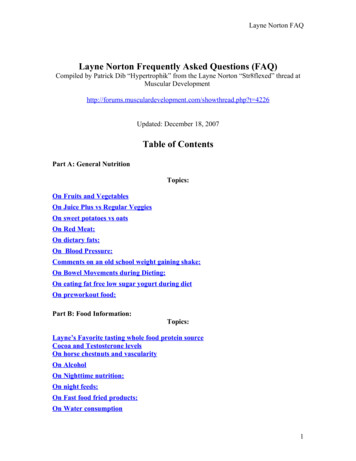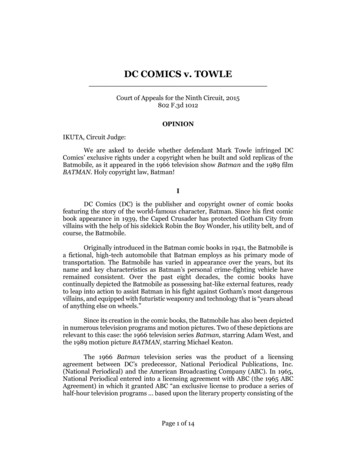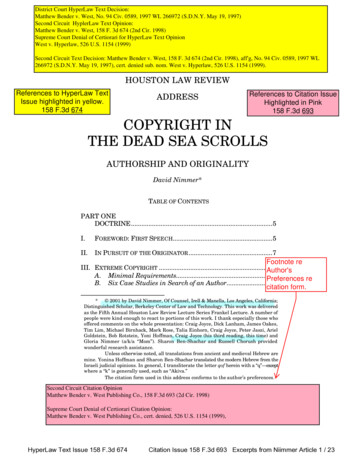
Transcription
CopyrightbyJo Layne Kehle2008
The Dissertation Committee for Jo Layne Kehlecertifies that this is the approved version of the following dissertation:THE LEADERSHIP OF ROSS O. SWIMMER 1975-1985:A CASE STUDY OF A MODERN CHEROKEE PRINCIPAL CHIEFCommittee:Martha N. Ovando, SupervisorRichard SchottNorma CantuNorvell NorthcuttPedro ReyesCharles T. Clark
THE LEADERSHIP OF ROSS O. SWIMMER 1975-1985:A CASE STUDY OF A MODERN CHEROKEE PRINCIPAL CHIEFbyJo Layne Kehle, B.A.; M.A.DissertationPresented to the Faculty of the Graduate School ofThe University of Texas at Austinin Partial Fulfillmentof the Requirementsfor the Degree ofDoctor of PhilosophyThe University of Texas at AustinDecember 2008
DedicationThis research project is a tribute to my parents: Allie Louvinue Johnson Sunday,and Clarence Floyd Sunday, who, after a life time together, learned to live in each other’sworld.Both sides of my family, the White and the Indian, prized and continue to valueeducation. There was, and never has been, such a thing as too much education. Onceone family member reached a certain level up the ladder of learning, a stop was made topull forward any family member left behind. This family tradition held firm in my questto begin and complete this dissertation.My sons, Peter Quinton Kehle, and Joel Ralph Kehle, provided a strong wind ofencouragement – one that refused to leave my back. Without the enduring faith and deeppool of resources provided by my sister, Dr. Karen Sunday Cockrell, and my brother-inlaw, Dr. Dan Cockrell, this manuscript would not exist. My Aunt Betty Jo Johnson wasmy treasure. Last, Eric, you were carried in my heart along this fascinating journey.The central core of my family is touched and circled by an invisible outer band ofthe study’s participants. Inestimable gratitude is owed to Ross and Margaret Swimmer,for their willing participation. Certainly the study’s wonderful Cherokee participants,both tribal members and non-tribal members, are extended a personal “Thank You” forthe contribution of their time, talent and information.
AcknowledgmentsRecognition is given to my Committee: Dr. Martha Ovando (Chair), Dr. RichardSchott, Dr. Norma Cantu, Dr. Norvell Northcutt, Dr. Charles Clark, and Dr. Pedro Reyes.Without their support and commitment to my interest in pursuing the study of leadershipoutside the normal realm of the Anglo-European-American perspective, the acceptance ofthis manuscript would not have been possible. A personal “Thank You” is due Dr.Charles Clark, as he advocated and encouraged the development of the research projectfrom its beginning. However, from each Committee Member, I have learned valuablelessons. The knowledge gained from the expertise of their specialties, is reflected withinthe pages of this manuscript.v
THE LEADERSHIP OF ROSS O. SWIMMER 1975-1985:A CASE STUDY OF A MODERN CHEROKEE PRINCIPAL CHIEFJo Layne Kehle, PhD.The University of Texas at Austin, 2008Supervisor: Martha N. OvandoThe following study examined leadership characteristics of a modern leader of theCherokee Nation, Ross O. Swimmer, during his three elections as Principal Chief, 19751985. Few Western scholars paid attention to the Cherokee Tribe after the break-up ofinstitutions legislated by the federal Indian policy of Allotment. The position of thegovernment was, the Cherokee Tribe no longer existed. For almost seventy years, noform of Cherokee leadership was visible; no Cherokee government existed. FederalIndian policy changed again, allowing tribes to elect their own leaders. This study beganfilling in gaps of missing information on modern Cherokee leadership by examiningSwimmer’s leadership characteristics. The study attempted to add to the body ofleadership knowledge by mining minds and memories, searching for the meaning ofleadership from a modern Cherokee perspective. The three questions guiding the studywere: what were the leadership characteristics of Principal Chief Ross O. Swimmer; towhat extent did these leadership characteristics reflect traditional Cherokee leadershipcharacteristics; and from a tribal perspective, did these make a difference, and to whatextent?vi
The data indicate seven Swimmer leadership characteristics: Visionary, GoalOriented, Bureaucratic, Top-Down, Authoritarian, Delegator, and Communicator. Therewas inconsistency with Swimmer’s use of traditional leadership practices. Swimmerused a combination of traditional Cherokee, traditional Native American, and AngloEuropean-American leadership characteristics during his three terms as Principal Chief ofthe Cherokee Nation. Two possible explanations for Swimmer’s blending leadershipcharacteristics from varying models were suggested. First, given his bi-cultural heritage,Swimmer could navigate back and forth between the mainstream White culture and thetraditional Cherokee culture, to pick and choose various types of leadershipcharacteristics. Second, adaptability has always been a unique characteristic of theCherokee people. Cherokee leaders frequently applied the feature of borrowing fromWhite culture in order to adapt and survive.Swimmer accomplished many of his goals for the Cherokee people and set theNation on a path of growth and stability. His methods were not without criticism fromtraditional Cherokees. However, Swimmer built the foundation for a corporategovernment that instilled pride in the Cherokee people and provided opportunity for selfsufficiency.vii
Table of ContentsChapter I: . 1Introduction . 1Statement of the Problem . 6Purpose of the Study . 9The Research Questions . 10Limitations 12Delimitations 13Assumptions . 13Significance of the Study . 14Definition of Terms . 15Summary . 19Chapter II: Review of the Literature . 21Introduction . 21Prominent Anglo-American Theories of Leadership . 22The Great Man or Trait Leadership Theory . 22Behaviors Leadership Theory . 23Situational Leadership Theory . 23Transformation Leadership Theory . 25viii
Participative Leadership Theory . 26The Characteristics of Authority and Power in Leadership . 26Charisma and Charismatic Leadership . 27Traditional Native American Leadership . 29Four Critical Aspects of Indian Nature: Physical, Mental,Emotional, Spiritual . 31Focus on Community Rather than the Individual 32The Orator 33The Pace of Native American Life . 34Highlights of Traditional Native AmericanLeadership Characteristics . 34Suggested Reasons for the Scarcity of Information onNative American Leadership . 35The Cherokee . 39The Towns – Early 17th Century Political Organization . 41Mixing Blood . 45The Co-Existence of Factionalism and Advancement . 46Changes in the Course of Cherokee Leadership . 49After Removal – The Years of 1839-1848 . 52Renaissance 1849-1860 53The Civil War – The Years of 1861-1871 . 54Allotment – The Years of 1872-1906 . 55Struggling to Remain Intact and Preserve Tribal Identity –The Years of 1907-1946 . 57ix
Important Events: Federal Legislation and the Electionof a Chief 58The Indian Reorganization Act (1934) 58World War II 601946 to the Administration of Ross Swimmer 60Cherokee Research and the Variance of Perspective . 61Summary . 63Chapter III: Methodology . 66Introduction . 66Purpose of the Study 67The Research Questions . 68Research Design . 69Researcher 70Reflexivity 71Selection of Participants . 71The Interview Participants 72Data Collection Methods and Analysis 74The Power of Observation 74Context for Selection of Interviewees . 75Characteristics of Cherokee Communication . 76Use of Documents 78Data Analysis . 80Trustworthiness 83x
Creditability . 83Transferability . 84Defendability . 84Confirmability . 85Always Expect the Unexpected 85Summary . 87Chapter IV: Historical, Political, and Cultural Factors Influencing the Policiesand Leadership of Principal Chief Ross O. Swimmer . 89Introduction . 89Setting the Stage: History, Politics, Policy and Culture During thePre-Swimmer Years (1839 through the Early 1970s) . 91The Founding of Tahlequah . 91Chief-for-a-Day 93The Indian Reorganization Act of 1934 Re-emphasized . 95The 1936 Oklahoma Indian General Welfare Act 95The 1946 Indian Claims Act and Principal ChiefJesse Bartley Milam . 96Tahlequah in the Early 1970s . 97Principal Chief W. W. Keeler . 101Ross O. Swimmer: Biographical Profile . 107The Birth of Ross O. Swimmer – 1943 107First Through Twelfth Grades . 110College . 111Ross Swimmer’s Siblings 112xi
Ross Swimmer’s Mother (Virginia Swimmer) 113Ross Swimmer’s Father (Robert Otis Swimmer) 113Ross Swimmer’s Thoughts on His Indian-White Background 114Lessons Learned from a Mentor . 116First Job 117The Importance of W. W. Keeler in the Development of aCherokee Chief: Keeler’s Influence and Legacy . 121Steps Toward Re-building the Cherokee Nation Prior to RossSwimmer’s Election as Principal Chief (1946-Early 1970s) 121Finding the Money 122From a One-Room Office to a Larger One-Room Building . 125Strength in Numbers . 127W. W. Keeler Becomes the Elected Chief of The Cherokees . 128The First Swimmer Myth (The Bank Situation) . 130Ross Swimmer’s Candidacy for Principal Chief Endorsedby W. W. Keeler . 136The Second Swimmer Myth (Changing a Rule) . 138Campaigning for Office . 141Summary . 144Chapter V: Findings – Cultural Environment, Leadership Characteristics,Comparative Analysis, and Accomplishments . 146Introduction . 146Cultural Influences 147Ross O. Swimmer’s First Term (1975-1979) . 150xii
Chart of the 1975 Vote Count . 151The Third Swimmer Myth (Spending Time at the BankInstead of Working for the Cherokee People) . 152Swimmer Starts to Build the Cherokee Nation’s Foundation . 154The 1976 “Swimmer” Constitution . 158The Cherokee Columns (Written by Ross O. Swimmer,Principal Chief) . 162Ross O. Swimmer’s Second Term (1979-1983) . 168The Bell Community Project – Implementing a Model forCommunity Self-Sufficiency 172Facing Cancer with Courage and Determination . 177Ross O. Swimmer’s Third Term (1983-1985) . 179Question 1 – Identified Leadership Characteristics of Ross O. Swimmer . 182Visionary/Goal Oriented . 183Bureaucratic/Top-Down . 186Organization Chart of the Cherokee Tribe (1975) 187Authoritarian . 189Delegator . 195Communicator . 197The Origins of Swimmer’s Chief Lieutenant 197Question 2 – Identified Swimmer Traditional CherokeeLeadership Characteristics 202Harmony Centered 205Significant Spiritual Component . 206xiii
The Gene Leroy Hart Story – Swimmer Respect for theCherokee Full-Blood and Cherokee Spirituality . 206Consensus Ruled/Avoidance of Open Conflict . 208Political Authority Vested in the Community, Not the Individual . 211Self-Interest Sublimated in the Interests of the Community 212Leaders Chosen Based on Competence 214Led by Example Rather than Authority or Command . 216Decisions Took Time; Their Word Was Binding . 217Comparative Analysis of Swimmer’s Leadership Characteristics . 219Question 3 – The Extent of Swimmer’s Accomplishments . 221Summary . 227Chapter VI: Summary Of Findings, Conclusions, And Recommendations . 229Introduction . 229Purpose of the Study 229Research Design and Procedures . 231Summary: Discussion of the Research QuestionsGuiding the Study 235Leadership characteristics of Ross O. Swimmer . 235Summary: Extent to which Swimmer’s Leadership CharacteristicsReflect Traditional Cherokee Leadership Characteristics 237Brayboy’s Thoughts on Blending Knowledge . 239Summary: From a Tribal Perspective, the Extent to whichSwimmer’s Leadership Characteristics Made a Difference . 240Foundations (Figure) 243xiv
Summary: Discussion of Findings Related toCurrent Leadership Theories 245Conclusions . 248Four Explanations Why Cherokee Leadership Is Ignored . 249A Gap In Knowledge 250How the Indian Voice Is Silenced 251The Hawk and the Dove . 252Combating the Mainstream Worldview 254Current Information and Concluding Thoughts on Ross O. Swimmer 256Appendix A: Did You Know . 259Appendix B: Example of Field Notes . 260Appendix C: Excerpts from Interviews . 264References 267Vitae . 288xv
CHAPTER IIntroductionAccording to Parman and Price, Robert F. Berfkhofer, Jr. theorized that“historians have treated Indians – along with other minority groups – as ‘passive objects’[within Anglo-European society] who produced no leaders of note, made no contributionsto [Anglo-European society], and therefore deserved little attention in American history”(Parman & Price, 1989, p. 185). According to Josephy, non-Anglo-European cultureshave legitimate ways of thinking about and looking at leadership, ways firmly groundedwithin their particular worldviews. As Josephy points out, “It takes a certain amount ofsophistication to realize that the vision of others who see the world from differentperspectives is just as valid as our own. One of the striking features of the administrativeor bureaucratic mind is that it lacks such sophistication” (Josephy, 1971, p. 22).Handed down from generation to generation are stories told by Cherokee eldersabout how Cherokees lived in the “Old Days” before they were removed from theiroriginal homelands during the years of 1838-1839 to their current home in Oklahoma. A“Cherokee legacy paid for with thousands of lives and millions of acres” (Smith, C.,1
2002, p. 12). These stories are filled with recitals of Cherokee oral history and itslessons, carried over centuries, through the past and present voices of its people.Embedded within these stories are the names of and the roles played by Cherokee leaders(Starr, 1984; Mooney, 1982).The survival of the Cherokee Nation provides a testament to the adaptability ofthe Cherokee people and their leaders. According to Strickland, whenever the Cherokeepeople would change and adapt, by necessity, to accommodate the demands of the federalgovernment, “Whites stepped in, and, through force of arms or legislation, destroyedwhat the Cherokees had accomplished. The pattern was repeated again and again”(Strickland, 1982, p. 8).This pattern of intrusion into Cherokee affairs began with English colonizationthat negatively affected the Cherokee government by creating deep divisions within theCherokee Nation (Porter, 1997). Further key historical events that disrupted theCherokee Nation’s formal leadership unfolded during three separate time periods inwhich the Cherokee people lost land and property (Strickland, 1982). First, in 1838, theU. S. federal government moved the Cherokees from their original homelands inTennessee and Georgia, to present-day Northeastern Oklahoma. After emerging from theTrail of Tears experience, the Cherokee people, under the guidance of their leaders, weredetermined to rebuild their tribe. According to Debo, the Cherokee “made suchremarkable social and political progress, they soon became known as [one] of the FiveCivilized Tribes” (Debo, 1991, p. 5). In the 1860s, Cherokee territory was the site ofmany Civil War battles and the loss of many Cherokee lives. Because a number of2
Cherokee leaders supported Confederate efforts, the Tribe bore the loss of land andproperty for a second time (Debo, 1991). Tasked with rebuilding once again, theCherokee successfully reestablished their government. However, the Cherokee peoplewere unsuccessful in their efforts to restrain the growing number of settlers whocontinued to seek access to Cherokee land. A complete dismantling of all Cherokeeinstitutions under the Curtis Act of 1898 followed the breakup of Cherokee communallyheld Tribal lands under the Dawes Severalty Act or General Allotment Act of 1887.Although the Dawes Act was actually passed eleven years prior to the Curtis Actof 1898, the Allotment process for the Five Civilized Tribes did not begin in full measureuntil the passage of the Curtis Act of 1898, as the Five Civilized Tribes were originallyexempt from allotment. However, The Dawes Commission was created in 1893, to“persuade” the Five Civilized Tribes to agree to the allotment process, and theCommission began enrolling members of the Five Civilized Tribes to speed the breakupof their land holdings (Cockrell, 2007).The federal policy known as Allotment created the legal mechanism by whichallotments of land were given to each Tribal member (Mankiller & Wallis, 1993; Deloria& Lytle, 1984). After 160 acres of land were awarded to each head-of-household, 80acres to a single Cherokee over eighteen years of age, the same to every orphan, and 40acres to every Cherokee under the age of 18, the remaining Cherokee land (the surplus)was opened to White settlement. The federal policy of Allotment instantaneouslyimpoverished the Cherokee.3
For almost seventy years, from approximately 1900 to 1970, the Cherokee Nation,under formal leadership, did not exist (O’Brien, 1989; Debo, 1991). Little is knownabout Cherokee leadership during this seventy-year period. However, the CherokeeNation survived under a cloak of intentional invisibility (Wahrhaftig, 2007). During thisperiod of relative silence, subtle adjustments were made to Cherokee traditionalleadership practices to accommodate the individualistic, capitalistic ways of the Whites(Porter, 1997). The Cherokee appeared to have a natural genius for politics. Accordingto Debo, “Trained through countless generations in the proud democracy of primitivecouncils, they found their borrowed Anglo-American institutions in perfect harmony withtheir native development” (Debo, 1991, p. 9). However, Debo also found the Cherokeepeople were deficient in practical judgment and business ability (Debo, 1991, p. 10).In 1970, federal Indian policy changed once again, and the members of theCherokee Nation were given the right to reorganize and elect their own Principal Chief.The first modern Cherokee elected Principal Chief was W. W. Keeler, the formerPresident of Phillips Petroleum Company. (Although Keeler was the first “modern”elected Principal Chief, he was considered culturally traditional by many Cherokeepeople.) Keeler served from 1971-1975. Ross O. Swimmer was elected in 1975, andresigned in 1985, to become head of the Bureau of Indian Affairs. Wilma Mankiller,Deputy Chief during Chief Swimmer’s tenure, not only became Principal Chief byCherokee constitutional law, she became the first woman Principal Chief of the CherokeeNation and was elected thereafter to three additional terms of office (Mankiller & Wallis,1993).4
Because the researcher grew up in Tahlequah, Oklahoma, the capital of theCherokee Nation, she heard the stories of adaptation and change; and these storiescomprise a sizable portion of the researcher’s family history. In early adulthood,however, life circumstances led the researcher to the world outside of Tahlequah.Experiences gained from stepping outside the boundary line of the Cherokee Nationsuggested to the researcher that the outside world knew very little about the Cherokeepeople.As the years and experiences of the researcher continued and grew, the gap inknowledge by the general public regarding the American Indian became increasinglyevident to her. First, the researcher noticed a lack of information in most history booksabout the cultures and histories of American Indians in general, or Cherokees inparticular. Next came the realization that American Indian leaders mentioned in books orseen in popular films were represented as conquered leaders of the past. In addition,Americans tended to group Indians together, as if they belonged to only one nation or oneculture. Weaver (2001) explains that Indians see “. . . themselves as members of theirown Nations rather than members of a larger group represented by the umbrella termNative American” (p. 242). Horse (2005) emphasizes: “We are Kiowa, Navajo,Comanche, Apache, Wichita, and so on” (p. 61). Similarly, Cherokee people seethemselves not as Indians, but as members of the Cherokee Nation.The researcher’s awareness grew about how people of all ages knew little aboutthe sacrifices and contributions Cherokee people have made to the growth anddevelopment of the United States, and knew little about how the Nation experienced5
centuries of suffering to survive. The Cherokee people’s remarkable accomplishmentsunder the guidance of their leaders are an “eloquent testimony to what William Faulknerdescribed as the enduring spirit of man” (Strickland, 1982, p. 3).In 1971, starting with one employee, the Cherokee Nation begin a journey on itsmost current road to rebuilding, once again, the Cherokee Nation. Under the currentleadership of Principal Chief Chad Smith, the Cherokee Nation employees 6,500 people(http://www.ChadSmith.com/WhatWeCanDo.htm, p. 1). This extraordinary growthprocess found its footing during the term of service of a modern day Principal Chief:Ross O. Swimmer.Statement of the ProblemProminent leadership theories of today are the product of past, current andongoing academic research presented from a European-American viewpoint (Smith,2005). Furthermore, the recognized leadership theories of today are largely based on aWhite worldview, which means that non-White perspectives are often absent or distorted.Academic research would benefit from a paradigm shift in the ways that we investigate,understand and study leadership (Bernal, 1998, p. 123). According to Bernal, ThomasKuhn presented a model in The Structure of Scientific Revolutions for a fundamentalchange in theories and scientific paradigms, arguing that, “Without major paradigm shiftswe may never understand certain scientific phenomena” (Bernal, 1998, p. 123). Kuhn’slogic might transfer to the study of leadership as well. Kuhn’s hypothesis suggests that aparadigm based solely on Anglo-European-American leadership styles (which excludeNative American leadership characteristics) constrains the study of leadership. The6
examination of leadership should not be forced into or limited by the paradigm of a singleworldview.Centuries before academia’s interest in leadership, hundreds of tribalgovernments, under the guidance of their leaders, were successfully operating on thiscontinent (O’Brien, 1989). However, inquiries encompassing an American Indianworldview of leadership theory are missing from the prominent academic literature. Thevoices of American Indian leaders appear to be absent from the discourse on leadership;and, if such is the case, these voices need to be identified and highlighted.Additionally, aspects and application of leadership from the worldview of theCherokee, specifically an application made in modern time, or the Modern Age, need tobe examined. As Ward (2003) posits, “Another name for the Modern Age is modernity.Modernity is connected to the idea of modernization. Modernization suggests updatingsomething, bringing something into line with present day needs” (Ward, p. 11).Co-existing with the problem of leadership theories developed only from anAnglo-European perspective is America’s continuing penchant for perpetuating the mythof the “Vanishing American.” Lee explains that Gerald Vizenor (Chippewa), one of thiscountry’s most prolific Native American writers, currently professor emeritus at theUniversity of California Berkeley, steadfastly rejected the “Vanishing American” ethos.Instead, Vizenor identified this ethos “as a mix of romanticized victimry and belief in‘Indians’ as fixed (heroically or otherwise)” (Vizenor & Lee, 1999, p. 4). This is not tosay that the Cherokee have not been studied. Current evidence of this phenomenonappeared in Penguin’s new Library of American Indian History announcing the7
publication of its first two books: The Cherokee Nation and the Trail of Tears (Perdue &Green, 2007) and The Shawnees and the War for America (Calloway, 2007). Ashistorically customary, Gathman’s review (2007) indicates both books are set in the 18thand 19th centuries (Austin American Statesman, Sunday, August 12, 2007, p. J5).Bass cautions that the study of leadership is highly fluid. From the moment ofone’s reading his classic, comprehensive leadership survey, Bass reminds his readingaudience that the findings of the survey are more than likely outdated due to the results ofcurrent, ongoing studies. However, Bass’s seminal book supports the impression there isa limited amount of Native American leadership discourse found in the literature. Bass’schapter on Leadership, Blacks, Hispanics, and Other Minorities contains five paragraphsdevoted to Native Americans. It begins: “Little can be said about this country’s mostimpoverished minority, whose members are undereducated [in Anglo-European ways andculture] and live mainly under tribal councils that discourage participatory democracyand collaborate with state bureaucracies to maintain the status quo. The leadership oftheir many famous chiefs of the past is only a memory” (Bass, 1990, p. 755).Bass is correct in stating, “The observed leadership tends to differ from one tribalculture to another” (Bass, 1990 p. 755). However, when referencing the work of Dekin(1985), Bass used the remaining paragraphs to illustrate leadership in one tribal group:the Inupiate of Alaska. It is a fair question to ask why one of the several hundred tribesin the other United States was not selected for a leadership discussion.This researcher believes that such skimpy attention to Native American leadershipnot only perpetuates the missing gap in information on Native American leadership8
(specifically, Cherokee leadership), but also prolongs the myth of the “VanishingAmerican,” and prevents us from knowing clearly the Cherokee perspective ofleadership.Purpose of the StudyThe purpose of this study is to examine the leadership characteristics of onePrincipal Chief of the Cherokee Nation, namely, Ross O. Swimmer, during hisadministration. Following the appointment of W. W. Keeler as Chief of the CherokeeNation by President Harry Truman (1949), President Richard M. Nixon (1970) ended thefederal government’s Indian policy of Termination (1945-1961). A new Indian policy ofSelf-Determination (1961) characterized the awakening of America’s social conscience.A major consequence of the repudiation of Termination was to allow the Indian tribes toelect their own leaders. In 1971, W. W. Keeler became the first elected Principal Chiefof the Cherokee Nation since Oklahoma statehood (1907). W. W. Keeler provided theinitial leadership necessary for Ross Swimmer, the following elected leader, to continuethe successful rebuilding of the Cherokee Nation (Deloria & Lytle, 1984; Conley, 2005;Mankiller & Wallis, 1993).To fulfill the purpose of this study, the researcher examined the administration ofone modern Cherokee Chief, Ross O. Swimmer, and examined the existence or absenceof traditional Cherokee leadership characteristics. Perhaps many such traditionalleadership characteristics, evidenced in or by practice, survived intact and were utilized.Perhaps, by necessity, the Chief blended and incorporated both traditional Cherokeeleadership characteristics and Anglo-European-American styles of leadership with his9
actions as a Cherokee leader. Possibly, traditional Cherokee leadership characteristicswere absent in Swimmer’s leadership decisions. This study attempts to add to the bodyof leadership knowledge by mining minds and memories, and searching for the meaningof leadership from a modern Cherokee perspective.The Research QuestionsThe case study examines the nature of modern Cherokee leadership during a past timeperiod, 1975-1985, through the lens of one Principal Chief of the Cherokee Nation: RossO. Swimmer. The research questions for the study were:1. What were the leadership characteristics of Principal Chief Ross O.Swimmer?2. To what extent did these leadership characteristics reflect traditional Cherokeeleadership char
Recognition is given to my Committee: Dr. Martha Ovando (Chair), Dr. Richard Schott, Dr. Norma Cantu, Dr. Norvell Northcutt, Dr. Charles Clark, and Dr. Pedro Reyes.










